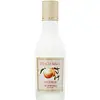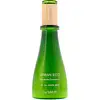What's inside
What's inside
 Key Ingredients
Key Ingredients

No key ingredients
 Benefits
Benefits

 Concerns
Concerns

 Ingredients Side-by-side
Ingredients Side-by-side

Water
Skin ConditioningPhenyl Trimethicone
Skin ConditioningAlcohol Denat.
AntimicrobialParaffinum Liquidum
EmollientBis-PEG-18 Methyl Ether Dimethyl Silane
EmollientIsohexadecane
EmollientPrunus Persica Fruit Extract
AbrasiveSorbitan Stearate
EmulsifyingPolyglyceryl-3 Methylglucose Distearate
EmulsifyingRice Ferment Filtrate
Skin ConditioningButylene Glycol
HumectantDimethicone
EmollientEthylhexylglycerin
Skin Conditioning1,2-Hexanediol
Skin ConditioningPropylene Glycol
HumectantCarbomer
Emulsion StabilisingAllantoin
Skin ConditioningTriethanolamine
BufferingSucrose Cocoate
EmulsifyingTocopheryl Acetate
AntioxidantArgania Spinosa Kernel Oil
EmollientHydrogenated Lecithin
EmulsifyingEnantia Chlorantha Bark Extract
Skin ConditioningDisodium EDTA
Sesamum Indicum Seed Oil
EmollientBHT
AntioxidantStearyl Glycyrrhetinate
Skin ConditioningBeta-Sitosterol
Emulsion StabilisingSerenoa Serrulata Fruit Extract
Skin ConditioningPhenoxyethanol
PreservativeTocopherol
AntioxidantGlycyrrhiza Glabra Root Extract
BleachingCentella Asiatica Extract
CleansingGlycine Soja Seed Extract
Skin ConditioningOleanolic Acid
Skin ConditioningChamomilla Recutita Flower Extract
MaskingParfum
MaskingSilica
AbrasiveCI 17200
Cosmetic ColorantCI 19140
Cosmetic ColorantCI 15985
Cosmetic ColorantWater, Phenyl Trimethicone, Alcohol Denat., Paraffinum Liquidum, Bis-PEG-18 Methyl Ether Dimethyl Silane, Isohexadecane, Prunus Persica Fruit Extract, Sorbitan Stearate, Polyglyceryl-3 Methylglucose Distearate, Rice Ferment Filtrate, Butylene Glycol, Dimethicone, Ethylhexylglycerin, 1,2-Hexanediol, Propylene Glycol, Carbomer, Allantoin, Triethanolamine, Sucrose Cocoate, Tocopheryl Acetate, Argania Spinosa Kernel Oil, Hydrogenated Lecithin, Enantia Chlorantha Bark Extract, Disodium EDTA, Sesamum Indicum Seed Oil, BHT, Stearyl Glycyrrhetinate, Beta-Sitosterol, Serenoa Serrulata Fruit Extract, Phenoxyethanol, Tocopherol, Glycyrrhiza Glabra Root Extract, Centella Asiatica Extract, Glycine Soja Seed Extract, Oleanolic Acid, Chamomilla Recutita Flower Extract, Parfum, Silica, CI 17200, CI 19140, CI 15985
Phormium Tenax Extract
Skin ConditioningButylene Glycol
HumectantGlycerin
HumectantMethyl Gluceth-10
EmulsifyingDimethicone
EmollientDimethiconol
EmollientGlyceryl Acrylate/Acrylic Acid Copolymer
HumectantCetearyl Olivate
Sorbitan Olivate
EmulsifyingCyclopentasiloxane
EmollientCyclohexasiloxane
EmollientPolyacrylamide
C13-14 Isoparaffin
EmollientLaureth-7
EmulsifyingPEG-60 Glyceryl Isostearate
Portulaca Oleracea Extract
Skin ConditioningAcrylates/C10-30 Alkyl Acrylate Crosspolymer
Emulsion StabilisingPotassium Hydroxide
BufferingPhenoxyethanol
PreservativeChlorphenesin
AntimicrobialParfum
MaskingDisodium EDTA
Honey
HumectantCalendula Officinalis Flower Water
MaskingPotassium Sorbate
PreservativeSodium Benzoate
MaskingCitric Acid
BufferingEchinacea Angustifolia Root Cell Culture Extract
Skin Conditioning1,2-Hexanediol
Skin ConditioningPhormium Tenax Extract, Butylene Glycol, Glycerin, Methyl Gluceth-10, Dimethicone, Dimethiconol, Glyceryl Acrylate/Acrylic Acid Copolymer, Cetearyl Olivate, Sorbitan Olivate, Cyclopentasiloxane, Cyclohexasiloxane, Polyacrylamide, C13-14 Isoparaffin, Laureth-7, PEG-60 Glyceryl Isostearate, Portulaca Oleracea Extract, Acrylates/C10-30 Alkyl Acrylate Crosspolymer, Potassium Hydroxide, Phenoxyethanol, Chlorphenesin, Parfum, Disodium EDTA, Honey, Calendula Officinalis Flower Water, Potassium Sorbate, Sodium Benzoate, Citric Acid, Echinacea Angustifolia Root Cell Culture Extract, 1,2-Hexanediol
Ingredients Explained
These ingredients are found in both products.
Ingredients higher up in an ingredient list are typically present in a larger amount.
1,2-Hexanediol is a synthetic liquid and another multi-functional powerhouse.
It is a:
- Humectant, drawing moisture into the skin
- Emollient, helping to soften skin
- Solvent, dispersing and stabilizing formulas
- Preservative booster, enhancing the antimicrobial activity of other preservatives
Butylene Glycol (or BG) is used within cosmetic products for a few different reasons:
Overall, Butylene Glycol is a safe and well-rounded ingredient that works well with other ingredients.
Though this ingredient works well with most skin types, some people with sensitive skin may experience a reaction such as allergic rashes, closed comedones, or itchiness.
Learn more about Butylene GlycolDimethicone is a type of synthetic silicone created from natural materials such as quartz.
What it does:
Dimethicone comes in different viscosities:
Depending on the viscosity, dimethicone has different properties.
Ingredients lists don't always show which type is used, so we recommend reaching out to the brand if you have questions about the viscosity.
This ingredient is unlikely to cause irritation because it does not get absorbed into skin. However, people with silicone allergies should be careful about using this ingredient.
Note: Dimethicone may contribute to pilling. This is because it is not oil or water soluble, so pilling may occur when layered with products. When mixed with heavy oils in a formula, the outcome is also quite greasy.
Learn more about DimethiconeDisodium EDTA plays a role in making products more stable by aiding other preservatives.
It is a chelating agent, meaning it neutralizes metal ions that may be found in a product.
Disodium EDTA is a salt of edetic acid and is found to be safe in cosmetic ingredients.
Learn more about Disodium EDTAParfum is a catch-all term for an ingredient or more that is used to give a scent to products.
Also called "fragrance", this ingredient can be a blend of hundreds of chemicals or plant oils. This means every product with "fragrance" or "parfum" in the ingredients list is a different mixture.
For instance, Habanolide is a proprietary trade name for a specific aroma chemical. When used as a fragrance ingredient in cosmetics, most aroma chemicals fall under the broad labeling category of “FRAGRANCE” or “PARFUM” according to EU and US regulations.
The term 'parfum' or 'fragrance' is not regulated in many countries. In many cases, it is up to the brand to define this term.
For instance, many brands choose to label themselves as "fragrance-free" because they are not using synthetic fragrances. However, their products may still contain ingredients such as essential oils that are considered a fragrance by INCI standards.
One example is Calendula flower extract. Calendula is an essential oil that still imparts a scent or 'fragrance'.
Depending on the blend, the ingredients in the mixture can cause allergies and sensitivities on the skin. Some ingredients that are known EU allergens include linalool and citronellol.
Parfum can also be used to mask or cover an unpleasant scent.
The bottom line is: not all fragrances/parfum/ingredients are created equally. If you are worried about fragrances, we recommend taking a closer look at an ingredient. And of course, we always recommend speaking with a professional.
Learn more about ParfumPhenoxyethanol is a preservative that has germicide, antimicrobial, and aromatic properties. Studies show that phenoxyethanol can prevent microbial growth. By itself, it has a scent that is similar to that of a rose.
It's often used in formulations along with Caprylyl Glycol to preserve the shelf life of products.